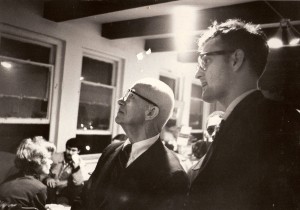Fred Good was born in Pittsburgh, Pennsylvania, of Belgian parents in 1940. He and his two younger brothers spent their early years attending public and private schools in Philadelphia, Pennsylvania, then Greenwich, Connecticut, Jacksonville, Florida, and Savannah, Georgia.

After completing an undergraduate degree in English at Georgetown University in Washington, D.C., Fred served two years as a lieutenant in the United States Army Artillery. He then joined his youngest brother, Michael, who had moved into an apartment at 605 East 6th Street on New York’s Lower East Side, an impoverished and rapidly decaying inner city neighborhood. Mike had befriended a group of teenaged Puerto Rican street gang leaders and their fellow gang members. Fred decided to stay in New York, become an artist and work with his new found friends. The next six years in the lives of the Good brothers and their friends is documented in a book entitled The Gang and the Establishment, published by Harper and Row (now Harper Collins) in 1970. It recounts the formation of The Real Great Society in 1965 and the founding of the University of the Streets in 1967, a project Fred conceived of with Robert Theobald, the noted British futurist and economist known for, among other books, The Guaranteed Income.(1996)
Both Fred and Mike, were drawn to the arts as adults. Mike was married in 1969 and moved to Maine, becoming a successful jewelry designer and sculptor, while Fred remained in New York City as a community organizer, while also studying drawing (Arts Student League), poetry (with Robert Boardman Vaughn) and psychology (with Jacob Moreno, founder of psychodrama). Fred was instrumental in helping to start a number of non-profit organizations, including The Real Great Society, The University of the Streets (a name Fred coined) and the Lower East Side Community Music Workshop, which is now a small private foundation supporting music projects .

The upper Lower East Side neighborhood is also now referred to as “Loisaida”, a name coined by Carlos (Chino) Garcia and the late Bimbo Rivas, two friends and activists with whom Fred has been closely associated. Fred and Chino continue their friendship and involvement in Loisaida today.
From 1946 through the mid 1960’s, Fred and his brothers spent their summers in Belgium on their grandparents’ estate. There they were exposed to the arts, receiving lessons in music, drawing, painting and sculpture. However, it was not until Fred moved with his wife and six year old daughter, Jessica, to Chapel Hill, NC, in 1981, that he pursued painting full time, studying watercolor at The Art School (now the ArtsCenter) in Carrboro, NC, and at the Durham Art Council in Durham, NC. Fred joined the Watercolor Society of North Carolina in 1984, serving as its Treasurer from 1985 to 1987. During this period he was accepted in numerous juried shows throughout North Carolina, often winning awards, and sold his paintings through galleries in Winston-Salem, Rocky Mount, Fayetteville and one person shows in Chapel Hill and Carrboro, NC.
In 1987, Fred founded New View Publications to support the work of his wife and her colleagues. The company has conducted workshops for over 10,000 school administrators, teachers and other helping professionals in the United States, Canada, Australia, Slovenia, Croatia and Indonesia, and has published several dozen books on applications of Perceptual Control Theory (PCT), an emerging scientific theory of behavior that is now gaining acceptance worldwide in a number of disciplines including cognitive psychology, neurology, sociology and artificial intelligence. The company also acts as a distributor of books on the science of PCT and its applications from other publishers. Fred and Perry were closely associated with the late William T. Powers, the originator of Perceptual Control Theory.(see pct web.org)
During the past five years, Fred has divided his time between painting and publishing.
During 1987-88, Fred served as President of Center Gallery in Carrboro (which became part of the ArtsCenter) and served as Board Chairman of The ArtsCenter in Carrboro from 1990-96.
References
New York Times; June 27, 1967
The Gang and the Establishment by Richard W. Poston; Harper and Row, New York, 1970.
CHARAS: The Improbable Dome Builders by Syeus Mottel; Drake Publishers, New York, 1973
Chapel Hill Newspaper; miscellaneous articles between 1990 thru 1996.